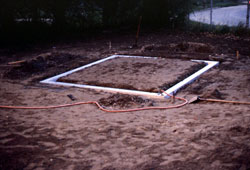

Winter
1979 Aluminum, crude oil, earth, grass and a unique site.
Installed at the Hudson River Museum, Yonkers, New York, situated in an open grass plain between the museum and the Hudson River. Looking out through the museumıs large west-facing windows across the river towards the palisades you look over and beyond WINTER but you donıt see it.
A form describing the perimeter of a 12´ x 12´ square constructed of aluminum tubing 6" square in cross section, mitered and welded at the corners, its sides cardinally oriented, filled with two barrels of crude oil and sealed, is placed level in the ground under 2" of soil and re-seeded. The openness of this grassy field as positioned between the museum and the river presents a uniquely appropriate site for this work. Here while not interrupting or interfering with the dynamic view of a great river ploughing past glacier-cut cliffs, it addresses congruent issues and invites their collaboration. Its orientation avoids local references asserting a global scope. Its elements: crude oil, aluminum, grass, earth, and the site, along with a simple form and title, in themselves and each by itself are evocative, however being together here their resonance is inflected also by simple physics, geology and notions about time and timing. Although crude oil, as found oozing from the ground, has been used through the ages in a variety of ways, ritually, medicinally, for warming winters and lighting the nights, and of course more recently and vitally as fuel for our machines, it has been drilled for commercially only since 1892 when the first well was drilled in Pennsylvania (where fortuitously this oil came from). Now as a globally crucial resource over which nations collide and upon which our lifestyles depend, it presides as the black icon of world power.
The crude in this piece lays quiet and unseen, invisible since the installation except as its specific heat, density, and placement may give it away, offering clues to its presence. The differences in the rates of heat absorption and dispersal in these materials create a lag in the temperature changes between the earth directly above the form and that of the earth surrounding it, thereby inviting traces of its presence, and as importantly an expectation that when weathers change they may appear. For instance, when after a prolonged cold spell and a light snow falls and then thereıs a thaw, the oil-filled form, being denser and having a higher specific heat than the surrounding dry grass-covered earth, stays cold longer persuading the snow directly above it to linger a bit offering a brief blossoming. The unpredictability and the sense of expectation more than any particular image are key here. In similar conditions such assertive tracings also occur above old, overgrown, long-forgotten stone covered graves and granite foundations. This oil tank has, in plan, the simple geometry and dimensions of what could be or could have been a small dwelling or encampment, just about anywhere, whenever. Although traces of WINTER, buried there beneath, are rarely visible, always the river is there, as are the seasons, our expectations of them and of our lives in time.
A form describing the perimeter of a 12´ x 12´ square constructed of aluminum tubing 6" square in cross section, mitered and welded at the corners, its sides cardinally oriented, filled with two barrels of crude oil and sealed, is placed level in the ground under 2" of soil and re-seeded. The openness of this grassy field as positioned between the museum and the river presents a uniquely appropriate site for this work. Here while not interrupting or interfering with the dynamic view of a great river ploughing past glacier-cut cliffs, it addresses congruent issues and invites their collaboration. Its orientation avoids local references asserting a global scope. Its elements: crude oil, aluminum, grass, earth, and the site, along with a simple form and title, in themselves and each by itself are evocative, however being together here their resonance is inflected also by simple physics, geology and notions about time and timing. Although crude oil, as found oozing from the ground, has been used through the ages in a variety of ways, ritually, medicinally, for warming winters and lighting the nights, and of course more recently and vitally as fuel for our machines, it has been drilled for commercially only since 1892 when the first well was drilled in Pennsylvania (where fortuitously this oil came from). Now as a globally crucial resource over which nations collide and upon which our lifestyles depend, it presides as the black icon of world power.
The crude in this piece lays quiet and unseen, invisible since the installation except as its specific heat, density, and placement may give it away, offering clues to its presence. The differences in the rates of heat absorption and dispersal in these materials create a lag in the temperature changes between the earth directly above the form and that of the earth surrounding it, thereby inviting traces of its presence, and as importantly an expectation that when weathers change they may appear. For instance, when after a prolonged cold spell and a light snow falls and then thereıs a thaw, the oil-filled form, being denser and having a higher specific heat than the surrounding dry grass-covered earth, stays cold longer persuading the snow directly above it to linger a bit offering a brief blossoming. The unpredictability and the sense of expectation more than any particular image are key here. In similar conditions such assertive tracings also occur above old, overgrown, long-forgotten stone covered graves and granite foundations. This oil tank has, in plan, the simple geometry and dimensions of what could be or could have been a small dwelling or encampment, just about anywhere, whenever. Although traces of WINTER, buried there beneath, are rarely visible, always the river is there, as are the seasons, our expectations of them and of our lives in time.